Business Environment Analysis
VerifiedAdded on 2020/01/28
|13
|3990
|297
Report
AI Summary
This report analyzes the business environment of Nestle, covering various aspects such as stakeholder influence, economic systems, fiscal and monetary policies, market structures, and international trade. It emphasizes the importance of adapting to internal and external factors affecting business operations and highlights the regulatory frameworks that Nestle adheres to in order to maintain a positive relationship with stakeholders and ensure compliance with legal standards.
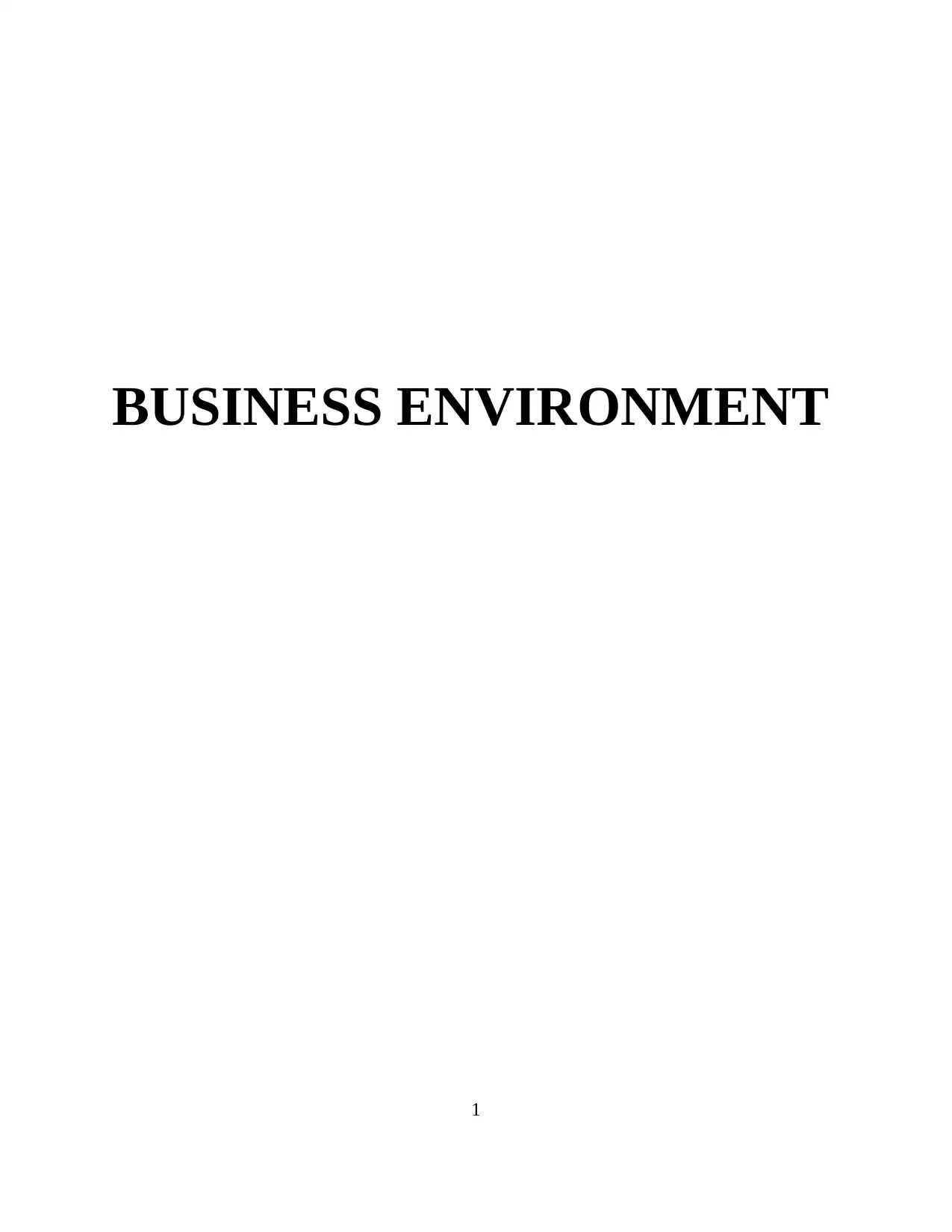
BUSINESS ENVIRONMENT
1
1
Paraphrase This Document
Need a fresh take? Get an instant paraphrase of this document with our AI Paraphraser
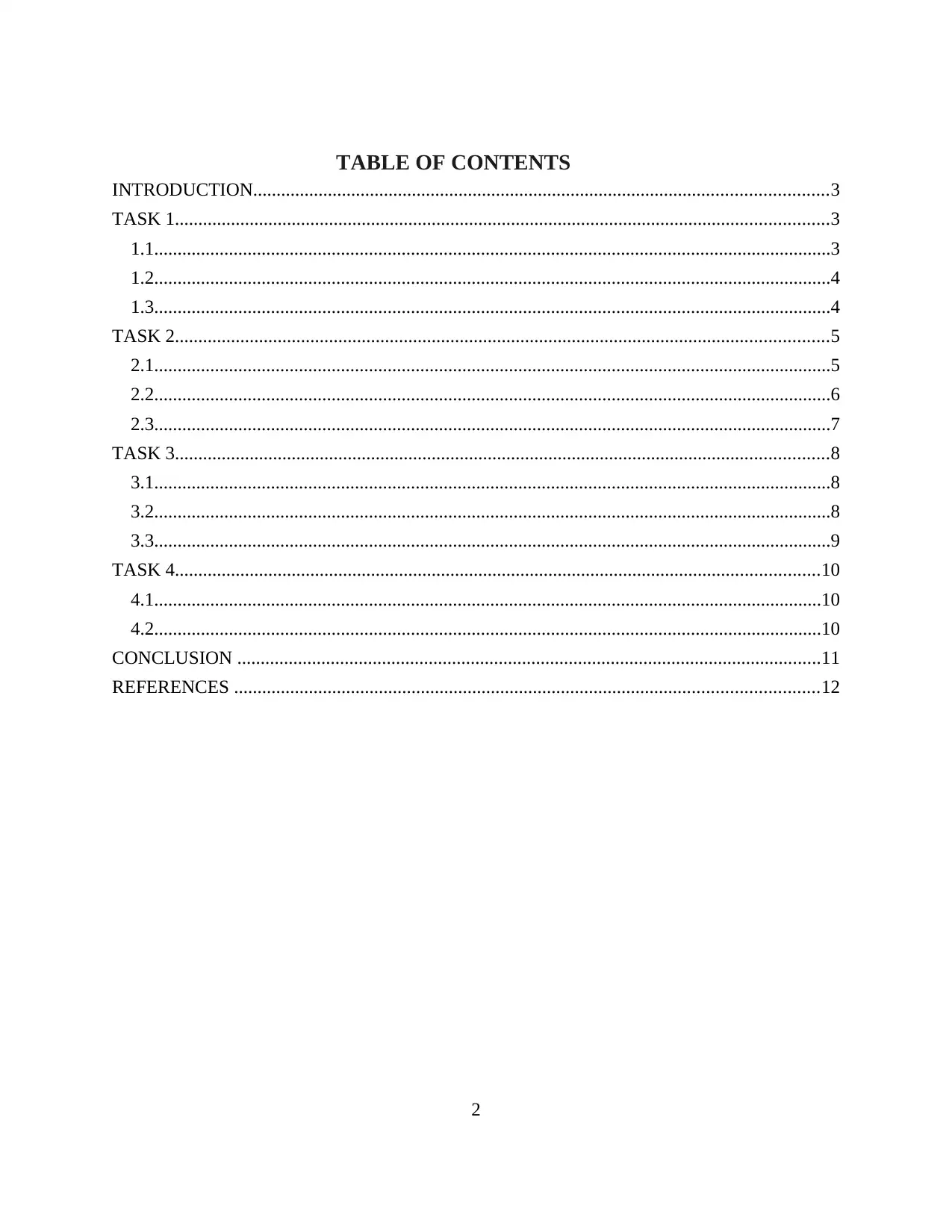
TABLE OF CONTENTS
INTRODUCTION...........................................................................................................................3
TASK 1............................................................................................................................................3
1.1.................................................................................................................................................3
1.2.................................................................................................................................................4
1.3.................................................................................................................................................4
TASK 2............................................................................................................................................5
2.1.................................................................................................................................................5
2.2.................................................................................................................................................6
2.3.................................................................................................................................................7
TASK 3............................................................................................................................................8
3.1.................................................................................................................................................8
3.2.................................................................................................................................................8
3.3.................................................................................................................................................9
TASK 4..........................................................................................................................................10
4.1...............................................................................................................................................10
4.2...............................................................................................................................................10
CONCLUSION .............................................................................................................................11
REFERENCES .............................................................................................................................12
2
INTRODUCTION...........................................................................................................................3
TASK 1............................................................................................................................................3
1.1.................................................................................................................................................3
1.2.................................................................................................................................................4
1.3.................................................................................................................................................4
TASK 2............................................................................................................................................5
2.1.................................................................................................................................................5
2.2.................................................................................................................................................6
2.3.................................................................................................................................................7
TASK 3............................................................................................................................................8
3.1.................................................................................................................................................8
3.2.................................................................................................................................................8
3.3.................................................................................................................................................9
TASK 4..........................................................................................................................................10
4.1...............................................................................................................................................10
4.2...............................................................................................................................................10
CONCLUSION .............................................................................................................................11
REFERENCES .............................................................................................................................12
2
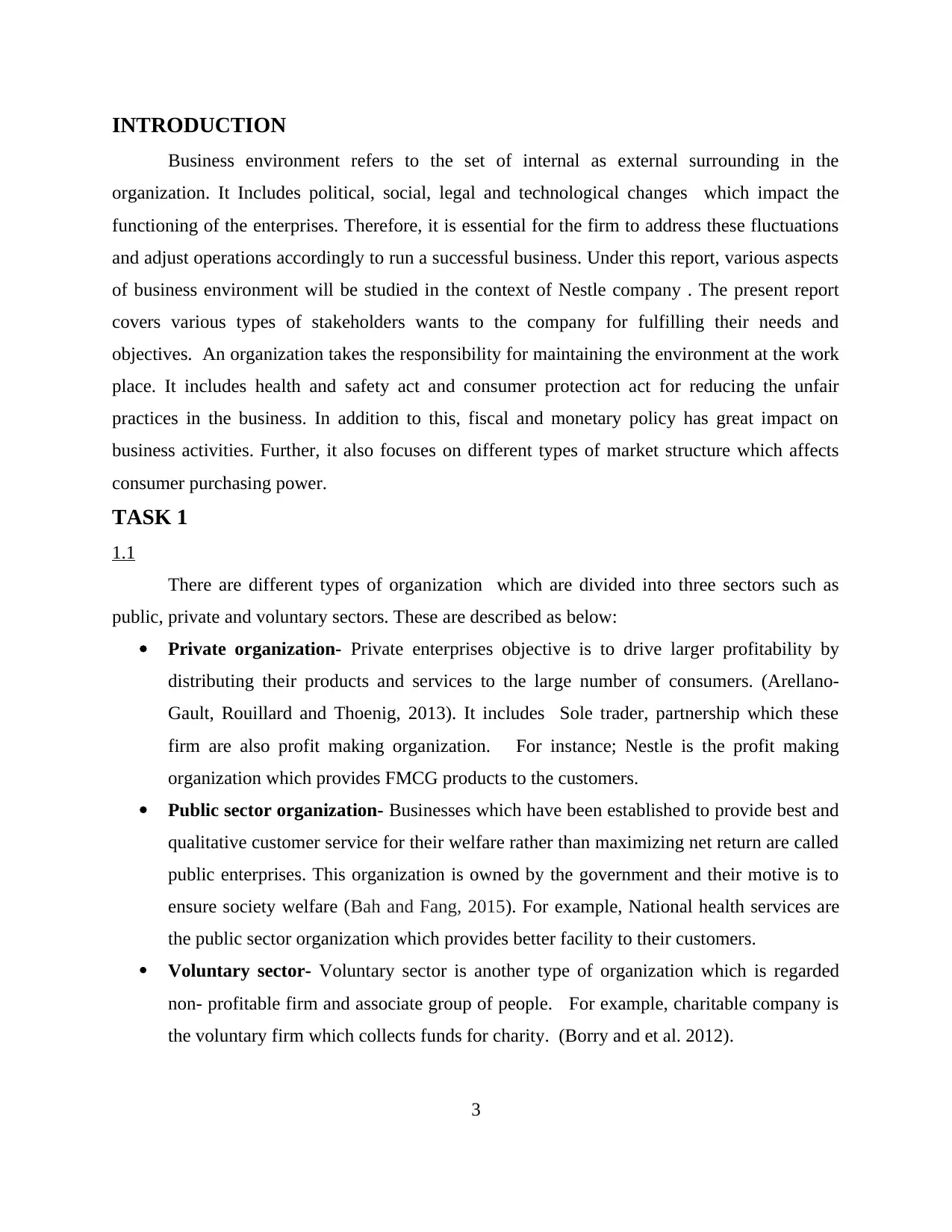
INTRODUCTION
Business environment refers to the set of internal as external surrounding in the
organization. It Includes political, social, legal and technological changes which impact the
functioning of the enterprises. Therefore, it is essential for the firm to address these fluctuations
and adjust operations accordingly to run a successful business. Under this report, various aspects
of business environment will be studied in the context of Nestle company . The present report
covers various types of stakeholders wants to the company for fulfilling their needs and
objectives. An organization takes the responsibility for maintaining the environment at the work
place. It includes health and safety act and consumer protection act for reducing the unfair
practices in the business. In addition to this, fiscal and monetary policy has great impact on
business activities. Further, it also focuses on different types of market structure which affects
consumer purchasing power.
TASK 1
1.1
There are different types of organization which are divided into three sectors such as
public, private and voluntary sectors. These are described as below:
Private organization- Private enterprises objective is to drive larger profitability by
distributing their products and services to the large number of consumers. (Arellano-
Gault, Rouillard and Thoenig, 2013). It includes Sole trader, partnership which these
firm are also profit making organization. For instance; Nestle is the profit making
organization which provides FMCG products to the customers.
Public sector organization- Businesses which have been established to provide best and
qualitative customer service for their welfare rather than maximizing net return are called
public enterprises. This organization is owned by the government and their motive is to
ensure society welfare (Bah and Fang, 2015). For example, National health services are
the public sector organization which provides better facility to their customers.
Voluntary sector- Voluntary sector is another type of organization which is regarded
non- profitable firm and associate group of people. For example, charitable company is
the voluntary firm which collects funds for charity. (Borry and et al. 2012).
3
Business environment refers to the set of internal as external surrounding in the
organization. It Includes political, social, legal and technological changes which impact the
functioning of the enterprises. Therefore, it is essential for the firm to address these fluctuations
and adjust operations accordingly to run a successful business. Under this report, various aspects
of business environment will be studied in the context of Nestle company . The present report
covers various types of stakeholders wants to the company for fulfilling their needs and
objectives. An organization takes the responsibility for maintaining the environment at the work
place. It includes health and safety act and consumer protection act for reducing the unfair
practices in the business. In addition to this, fiscal and monetary policy has great impact on
business activities. Further, it also focuses on different types of market structure which affects
consumer purchasing power.
TASK 1
1.1
There are different types of organization which are divided into three sectors such as
public, private and voluntary sectors. These are described as below:
Private organization- Private enterprises objective is to drive larger profitability by
distributing their products and services to the large number of consumers. (Arellano-
Gault, Rouillard and Thoenig, 2013). It includes Sole trader, partnership which these
firm are also profit making organization. For instance; Nestle is the profit making
organization which provides FMCG products to the customers.
Public sector organization- Businesses which have been established to provide best and
qualitative customer service for their welfare rather than maximizing net return are called
public enterprises. This organization is owned by the government and their motive is to
ensure society welfare (Bah and Fang, 2015). For example, National health services are
the public sector organization which provides better facility to their customers.
Voluntary sector- Voluntary sector is another type of organization which is regarded
non- profitable firm and associate group of people. For example, charitable company is
the voluntary firm which collects funds for charity. (Borry and et al. 2012).
3
⊘ This is a preview!⊘
Do you want full access?
Subscribe today to unlock all pages.

Trusted by 1+ million students worldwide
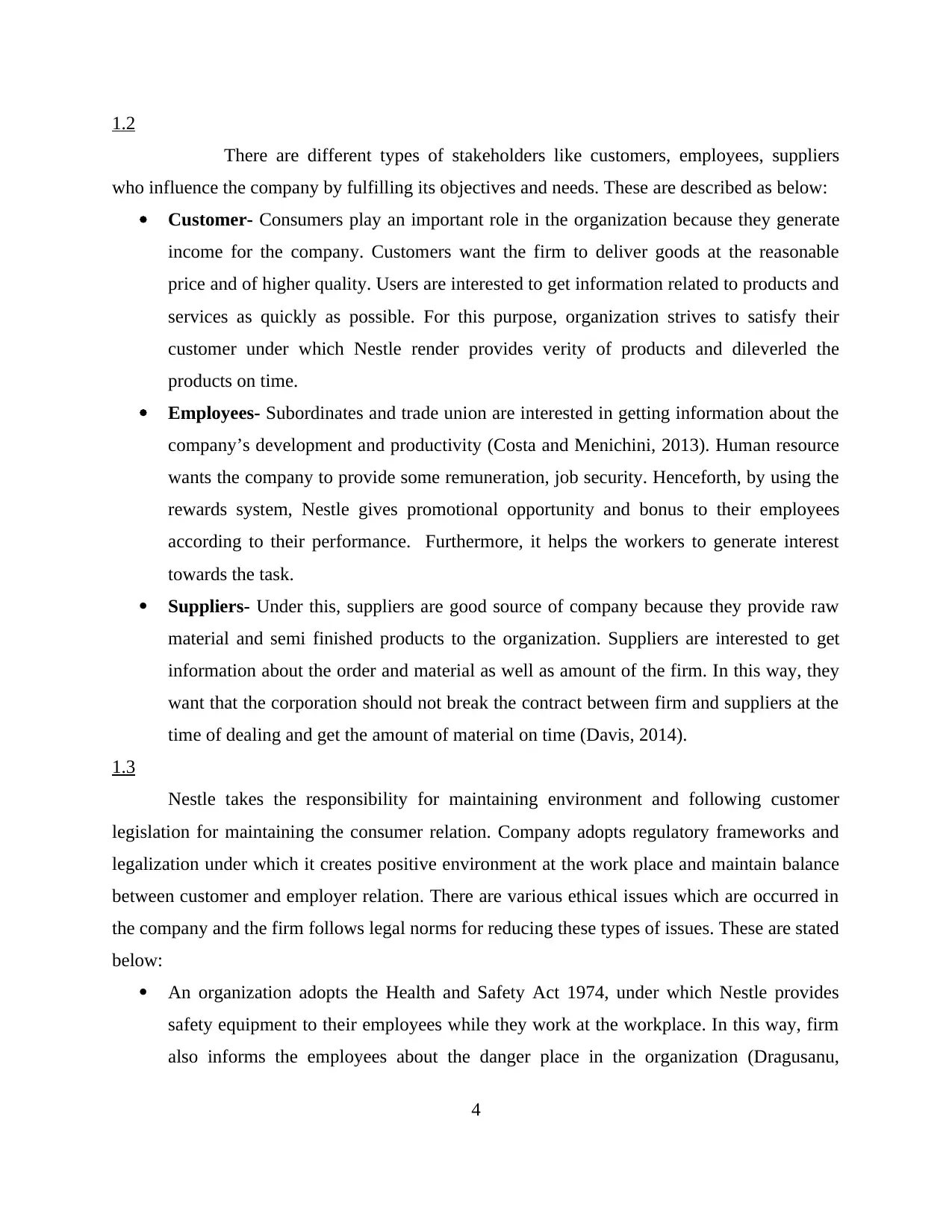
1.2
There are different types of stakeholders like customers, employees, suppliers
who influence the company by fulfilling its objectives and needs. These are described as below:
Customer- Consumers play an important role in the organization because they generate
income for the company. Customers want the firm to deliver goods at the reasonable
price and of higher quality. Users are interested to get information related to products and
services as quickly as possible. For this purpose, organization strives to satisfy their
customer under which Nestle render provides verity of products and dileverled the
products on time.
Employees- Subordinates and trade union are interested in getting information about the
company’s development and productivity (Costa and Menichini, 2013). Human resource
wants the company to provide some remuneration, job security. Henceforth, by using the
rewards system, Nestle gives promotional opportunity and bonus to their employees
according to their performance. Furthermore, it helps the workers to generate interest
towards the task.
Suppliers- Under this, suppliers are good source of company because they provide raw
material and semi finished products to the organization. Suppliers are interested to get
information about the order and material as well as amount of the firm. In this way, they
want that the corporation should not break the contract between firm and suppliers at the
time of dealing and get the amount of material on time (Davis, 2014).
1.3
Nestle takes the responsibility for maintaining environment and following customer
legislation for maintaining the consumer relation. Company adopts regulatory frameworks and
legalization under which it creates positive environment at the work place and maintain balance
between customer and employer relation. There are various ethical issues which are occurred in
the company and the firm follows legal norms for reducing these types of issues. These are stated
below:
An organization adopts the Health and Safety Act 1974, under which Nestle provides
safety equipment to their employees while they work at the workplace. In this way, firm
also informs the employees about the danger place in the organization (Dragusanu,
4
There are different types of stakeholders like customers, employees, suppliers
who influence the company by fulfilling its objectives and needs. These are described as below:
Customer- Consumers play an important role in the organization because they generate
income for the company. Customers want the firm to deliver goods at the reasonable
price and of higher quality. Users are interested to get information related to products and
services as quickly as possible. For this purpose, organization strives to satisfy their
customer under which Nestle render provides verity of products and dileverled the
products on time.
Employees- Subordinates and trade union are interested in getting information about the
company’s development and productivity (Costa and Menichini, 2013). Human resource
wants the company to provide some remuneration, job security. Henceforth, by using the
rewards system, Nestle gives promotional opportunity and bonus to their employees
according to their performance. Furthermore, it helps the workers to generate interest
towards the task.
Suppliers- Under this, suppliers are good source of company because they provide raw
material and semi finished products to the organization. Suppliers are interested to get
information about the order and material as well as amount of the firm. In this way, they
want that the corporation should not break the contract between firm and suppliers at the
time of dealing and get the amount of material on time (Davis, 2014).
1.3
Nestle takes the responsibility for maintaining environment and following customer
legislation for maintaining the consumer relation. Company adopts regulatory frameworks and
legalization under which it creates positive environment at the work place and maintain balance
between customer and employer relation. There are various ethical issues which are occurred in
the company and the firm follows legal norms for reducing these types of issues. These are stated
below:
An organization adopts the Health and Safety Act 1974, under which Nestle provides
safety equipment to their employees while they work at the workplace. In this way, firm
also informs the employees about the danger place in the organization (Dragusanu,
4
Paraphrase This Document
Need a fresh take? Get an instant paraphrase of this document with our AI Paraphraser
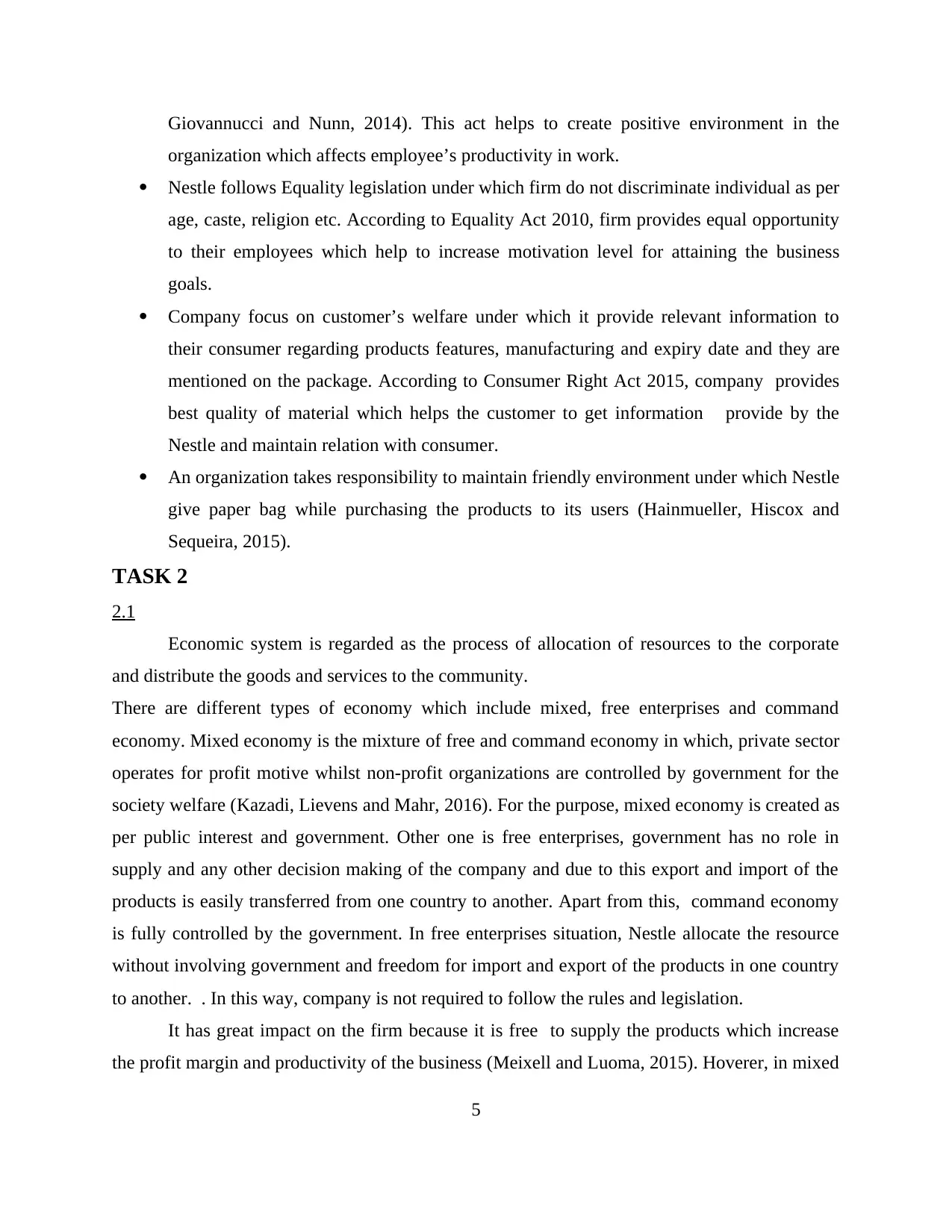
Giovannucci and Nunn, 2014). This act helps to create positive environment in the
organization which affects employee’s productivity in work.
Nestle follows Equality legislation under which firm do not discriminate individual as per
age, caste, religion etc. According to Equality Act 2010, firm provides equal opportunity
to their employees which help to increase motivation level for attaining the business
goals.
Company focus on customer’s welfare under which it provide relevant information to
their consumer regarding products features, manufacturing and expiry date and they are
mentioned on the package. According to Consumer Right Act 2015, company provides
best quality of material which helps the customer to get information provide by the
Nestle and maintain relation with consumer.
An organization takes responsibility to maintain friendly environment under which Nestle
give paper bag while purchasing the products to its users (Hainmueller, Hiscox and
Sequeira, 2015).
TASK 2
2.1
Economic system is regarded as the process of allocation of resources to the corporate
and distribute the goods and services to the community.
There are different types of economy which include mixed, free enterprises and command
economy. Mixed economy is the mixture of free and command economy in which, private sector
operates for profit motive whilst non-profit organizations are controlled by government for the
society welfare (Kazadi, Lievens and Mahr, 2016). For the purpose, mixed economy is created as
per public interest and government. Other one is free enterprises, government has no role in
supply and any other decision making of the company and due to this export and import of the
products is easily transferred from one country to another. Apart from this, command economy
is fully controlled by the government. In free enterprises situation, Nestle allocate the resource
without involving government and freedom for import and export of the products in one country
to another. . In this way, company is not required to follow the rules and legislation.
It has great impact on the firm because it is free to supply the products which increase
the profit margin and productivity of the business (Meixell and Luoma, 2015). Hoverer, in mixed
5
organization which affects employee’s productivity in work.
Nestle follows Equality legislation under which firm do not discriminate individual as per
age, caste, religion etc. According to Equality Act 2010, firm provides equal opportunity
to their employees which help to increase motivation level for attaining the business
goals.
Company focus on customer’s welfare under which it provide relevant information to
their consumer regarding products features, manufacturing and expiry date and they are
mentioned on the package. According to Consumer Right Act 2015, company provides
best quality of material which helps the customer to get information provide by the
Nestle and maintain relation with consumer.
An organization takes responsibility to maintain friendly environment under which Nestle
give paper bag while purchasing the products to its users (Hainmueller, Hiscox and
Sequeira, 2015).
TASK 2
2.1
Economic system is regarded as the process of allocation of resources to the corporate
and distribute the goods and services to the community.
There are different types of economy which include mixed, free enterprises and command
economy. Mixed economy is the mixture of free and command economy in which, private sector
operates for profit motive whilst non-profit organizations are controlled by government for the
society welfare (Kazadi, Lievens and Mahr, 2016). For the purpose, mixed economy is created as
per public interest and government. Other one is free enterprises, government has no role in
supply and any other decision making of the company and due to this export and import of the
products is easily transferred from one country to another. Apart from this, command economy
is fully controlled by the government. In free enterprises situation, Nestle allocate the resource
without involving government and freedom for import and export of the products in one country
to another. . In this way, company is not required to follow the rules and legislation.
It has great impact on the firm because it is free to supply the products which increase
the profit margin and productivity of the business (Meixell and Luoma, 2015). Hoverer, in mixed
5
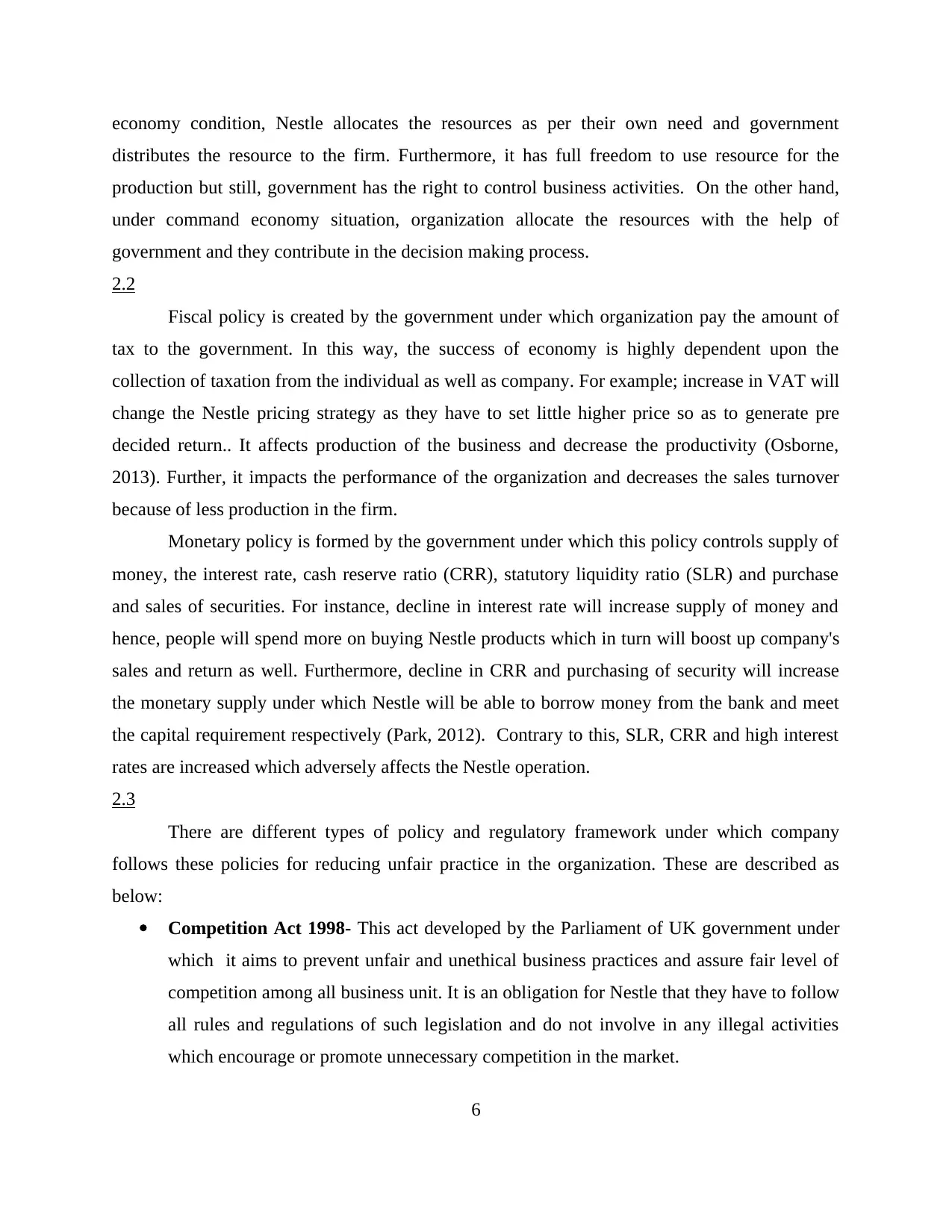
economy condition, Nestle allocates the resources as per their own need and government
distributes the resource to the firm. Furthermore, it has full freedom to use resource for the
production but still, government has the right to control business activities. On the other hand,
under command economy situation, organization allocate the resources with the help of
government and they contribute in the decision making process.
2.2
Fiscal policy is created by the government under which organization pay the amount of
tax to the government. In this way, the success of economy is highly dependent upon the
collection of taxation from the individual as well as company. For example; increase in VAT will
change the Nestle pricing strategy as they have to set little higher price so as to generate pre
decided return.. It affects production of the business and decrease the productivity (Osborne,
2013). Further, it impacts the performance of the organization and decreases the sales turnover
because of less production in the firm.
Monetary policy is formed by the government under which this policy controls supply of
money, the interest rate, cash reserve ratio (CRR), statutory liquidity ratio (SLR) and purchase
and sales of securities. For instance, decline in interest rate will increase supply of money and
hence, people will spend more on buying Nestle products which in turn will boost up company's
sales and return as well. Furthermore, decline in CRR and purchasing of security will increase
the monetary supply under which Nestle will be able to borrow money from the bank and meet
the capital requirement respectively (Park, 2012). Contrary to this, SLR, CRR and high interest
rates are increased which adversely affects the Nestle operation.
2.3
There are different types of policy and regulatory framework under which company
follows these policies for reducing unfair practice in the organization. These are described as
below:
Competition Act 1998- This act developed by the Parliament of UK government under
which it aims to prevent unfair and unethical business practices and assure fair level of
competition among all business unit. It is an obligation for Nestle that they have to follow
all rules and regulations of such legislation and do not involve in any illegal activities
which encourage or promote unnecessary competition in the market.
6
distributes the resource to the firm. Furthermore, it has full freedom to use resource for the
production but still, government has the right to control business activities. On the other hand,
under command economy situation, organization allocate the resources with the help of
government and they contribute in the decision making process.
2.2
Fiscal policy is created by the government under which organization pay the amount of
tax to the government. In this way, the success of economy is highly dependent upon the
collection of taxation from the individual as well as company. For example; increase in VAT will
change the Nestle pricing strategy as they have to set little higher price so as to generate pre
decided return.. It affects production of the business and decrease the productivity (Osborne,
2013). Further, it impacts the performance of the organization and decreases the sales turnover
because of less production in the firm.
Monetary policy is formed by the government under which this policy controls supply of
money, the interest rate, cash reserve ratio (CRR), statutory liquidity ratio (SLR) and purchase
and sales of securities. For instance, decline in interest rate will increase supply of money and
hence, people will spend more on buying Nestle products which in turn will boost up company's
sales and return as well. Furthermore, decline in CRR and purchasing of security will increase
the monetary supply under which Nestle will be able to borrow money from the bank and meet
the capital requirement respectively (Park, 2012). Contrary to this, SLR, CRR and high interest
rates are increased which adversely affects the Nestle operation.
2.3
There are different types of policy and regulatory framework under which company
follows these policies for reducing unfair practice in the organization. These are described as
below:
Competition Act 1998- This act developed by the Parliament of UK government under
which it aims to prevent unfair and unethical business practices and assure fair level of
competition among all business unit. It is an obligation for Nestle that they have to follow
all rules and regulations of such legislation and do not involve in any illegal activities
which encourage or promote unnecessary competition in the market.
6
⊘ This is a preview!⊘
Do you want full access?
Subscribe today to unlock all pages.

Trusted by 1+ million students worldwide
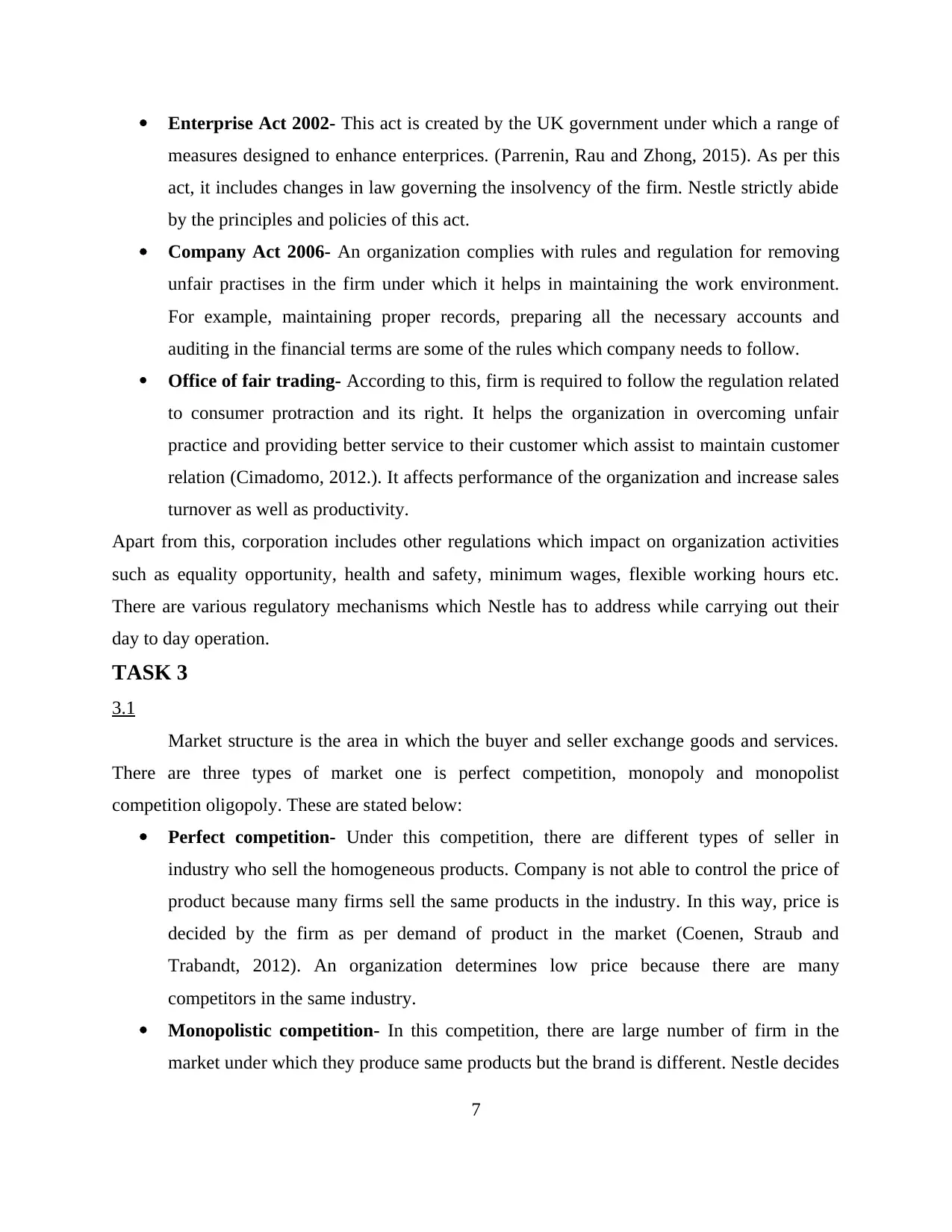
Enterprise Act 2002- This act is created by the UK government under which a range of
measures designed to enhance enterprices. (Parrenin, Rau and Zhong, 2015). As per this
act, it includes changes in law governing the insolvency of the firm. Nestle strictly abide
by the principles and policies of this act.
Company Act 2006- An organization complies with rules and regulation for removing
unfair practises in the firm under which it helps in maintaining the work environment.
For example, maintaining proper records, preparing all the necessary accounts and
auditing in the financial terms are some of the rules which company needs to follow.
Office of fair trading- According to this, firm is required to follow the regulation related
to consumer protraction and its right. It helps the organization in overcoming unfair
practice and providing better service to their customer which assist to maintain customer
relation (Cimadomo, 2012.). It affects performance of the organization and increase sales
turnover as well as productivity.
Apart from this, corporation includes other regulations which impact on organization activities
such as equality opportunity, health and safety, minimum wages, flexible working hours etc.
There are various regulatory mechanisms which Nestle has to address while carrying out their
day to day operation.
TASK 3
3.1
Market structure is the area in which the buyer and seller exchange goods and services.
There are three types of market one is perfect competition, monopoly and monopolist
competition oligopoly. These are stated below:
Perfect competition- Under this competition, there are different types of seller in
industry who sell the homogeneous products. Company is not able to control the price of
product because many firms sell the same products in the industry. In this way, price is
decided by the firm as per demand of product in the market (Coenen, Straub and
Trabandt, 2012). An organization determines low price because there are many
competitors in the same industry.
Monopolistic competition- In this competition, there are large number of firm in the
market under which they produce same products but the brand is different. Nestle decides
7
measures designed to enhance enterprices. (Parrenin, Rau and Zhong, 2015). As per this
act, it includes changes in law governing the insolvency of the firm. Nestle strictly abide
by the principles and policies of this act.
Company Act 2006- An organization complies with rules and regulation for removing
unfair practises in the firm under which it helps in maintaining the work environment.
For example, maintaining proper records, preparing all the necessary accounts and
auditing in the financial terms are some of the rules which company needs to follow.
Office of fair trading- According to this, firm is required to follow the regulation related
to consumer protraction and its right. It helps the organization in overcoming unfair
practice and providing better service to their customer which assist to maintain customer
relation (Cimadomo, 2012.). It affects performance of the organization and increase sales
turnover as well as productivity.
Apart from this, corporation includes other regulations which impact on organization activities
such as equality opportunity, health and safety, minimum wages, flexible working hours etc.
There are various regulatory mechanisms which Nestle has to address while carrying out their
day to day operation.
TASK 3
3.1
Market structure is the area in which the buyer and seller exchange goods and services.
There are three types of market one is perfect competition, monopoly and monopolist
competition oligopoly. These are stated below:
Perfect competition- Under this competition, there are different types of seller in
industry who sell the homogeneous products. Company is not able to control the price of
product because many firms sell the same products in the industry. In this way, price is
decided by the firm as per demand of product in the market (Coenen, Straub and
Trabandt, 2012). An organization determines low price because there are many
competitors in the same industry.
Monopolistic competition- In this competition, there are large number of firm in the
market under which they produce same products but the brand is different. Nestle decides
7
Paraphrase This Document
Need a fresh take? Get an instant paraphrase of this document with our AI Paraphraser
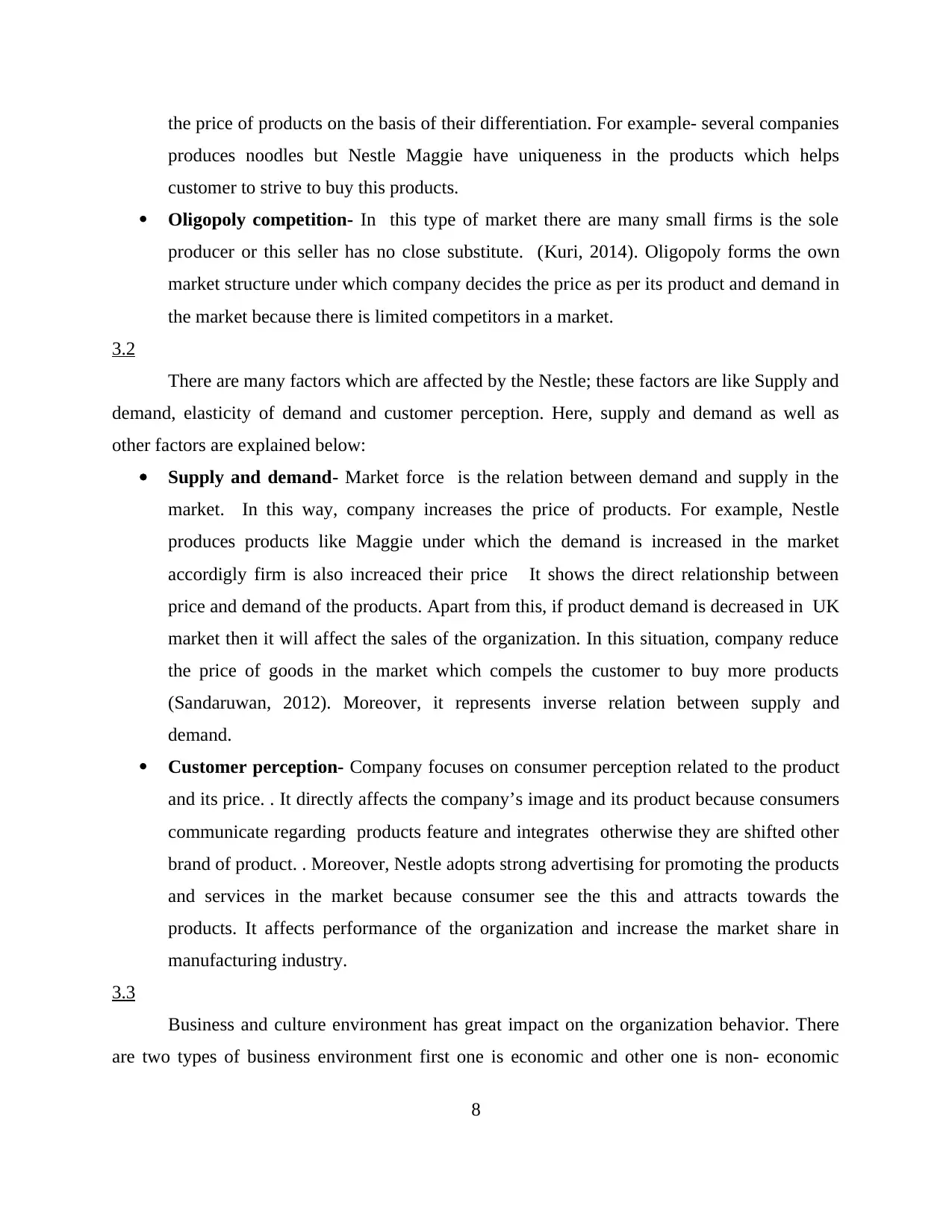
the price of products on the basis of their differentiation. For example- several companies
produces noodles but Nestle Maggie have uniqueness in the products which helps
customer to strive to buy this products.
Oligopoly competition- In this type of market there are many small firms is the sole
producer or this seller has no close substitute. (Kuri, 2014). Oligopoly forms the own
market structure under which company decides the price as per its product and demand in
the market because there is limited competitors in a market.
3.2
There are many factors which are affected by the Nestle; these factors are like Supply and
demand, elasticity of demand and customer perception. Here, supply and demand as well as
other factors are explained below:
Supply and demand- Market force is the relation between demand and supply in the
market. In this way, company increases the price of products. For example, Nestle
produces products like Maggie under which the demand is increased in the market
accordigly firm is also increaced their price It shows the direct relationship between
price and demand of the products. Apart from this, if product demand is decreased in UK
market then it will affect the sales of the organization. In this situation, company reduce
the price of goods in the market which compels the customer to buy more products
(Sandaruwan, 2012). Moreover, it represents inverse relation between supply and
demand.
Customer perception- Company focuses on consumer perception related to the product
and its price. . It directly affects the company’s image and its product because consumers
communicate regarding products feature and integrates otherwise they are shifted other
brand of product. . Moreover, Nestle adopts strong advertising for promoting the products
and services in the market because consumer see the this and attracts towards the
products. It affects performance of the organization and increase the market share in
manufacturing industry.
3.3
Business and culture environment has great impact on the organization behavior. There
are two types of business environment first one is economic and other one is non- economic
8
produces noodles but Nestle Maggie have uniqueness in the products which helps
customer to strive to buy this products.
Oligopoly competition- In this type of market there are many small firms is the sole
producer or this seller has no close substitute. (Kuri, 2014). Oligopoly forms the own
market structure under which company decides the price as per its product and demand in
the market because there is limited competitors in a market.
3.2
There are many factors which are affected by the Nestle; these factors are like Supply and
demand, elasticity of demand and customer perception. Here, supply and demand as well as
other factors are explained below:
Supply and demand- Market force is the relation between demand and supply in the
market. In this way, company increases the price of products. For example, Nestle
produces products like Maggie under which the demand is increased in the market
accordigly firm is also increaced their price It shows the direct relationship between
price and demand of the products. Apart from this, if product demand is decreased in UK
market then it will affect the sales of the organization. In this situation, company reduce
the price of goods in the market which compels the customer to buy more products
(Sandaruwan, 2012). Moreover, it represents inverse relation between supply and
demand.
Customer perception- Company focuses on consumer perception related to the product
and its price. . It directly affects the company’s image and its product because consumers
communicate regarding products feature and integrates otherwise they are shifted other
brand of product. . Moreover, Nestle adopts strong advertising for promoting the products
and services in the market because consumer see the this and attracts towards the
products. It affects performance of the organization and increase the market share in
manufacturing industry.
3.3
Business and culture environment has great impact on the organization behavior. There
are two types of business environment first one is economic and other one is non- economic
8
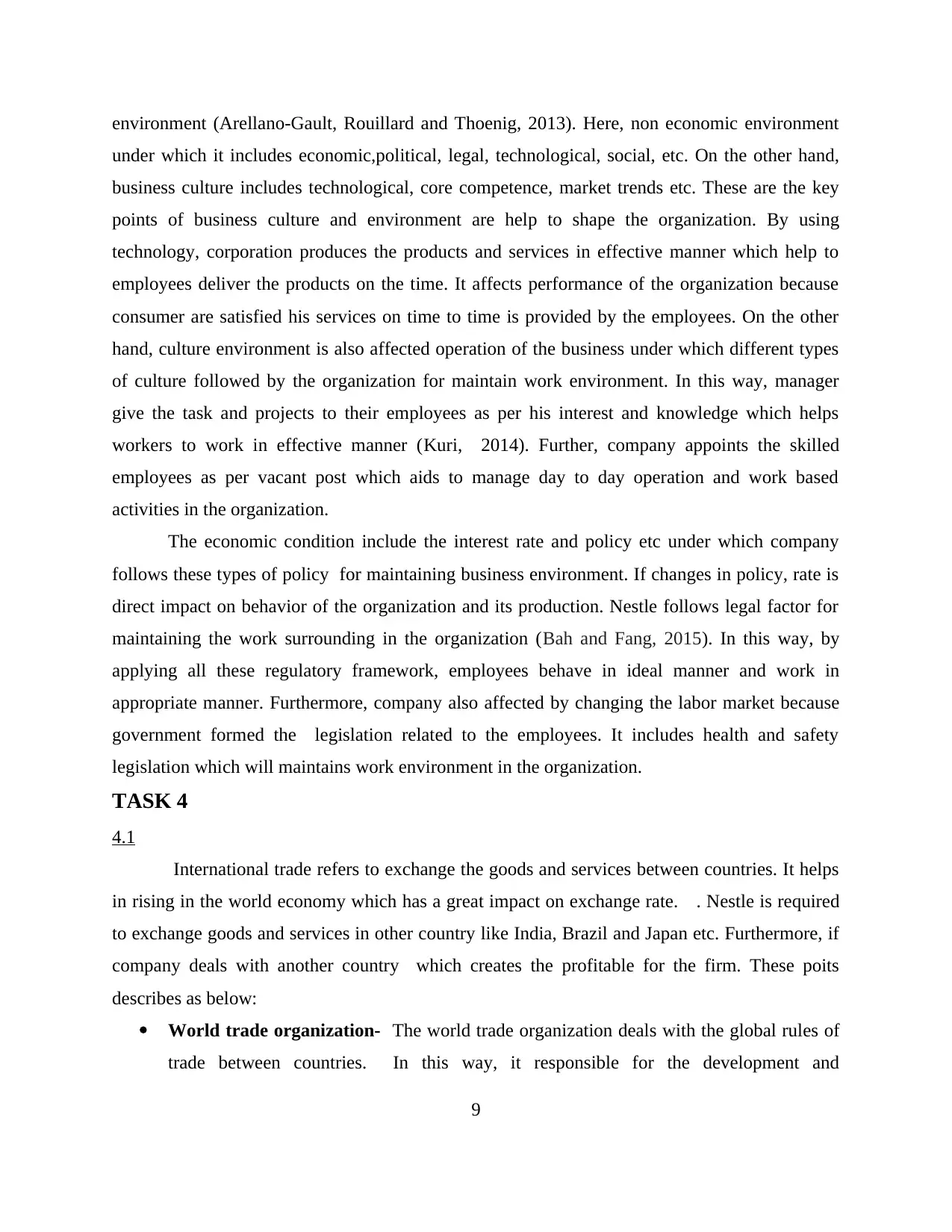
environment (Arellano-Gault, Rouillard and Thoenig, 2013). Here, non economic environment
under which it includes economic,political, legal, technological, social, etc. On the other hand,
business culture includes technological, core competence, market trends etc. These are the key
points of business culture and environment are help to shape the organization. By using
technology, corporation produces the products and services in effective manner which help to
employees deliver the products on the time. It affects performance of the organization because
consumer are satisfied his services on time to time is provided by the employees. On the other
hand, culture environment is also affected operation of the business under which different types
of culture followed by the organization for maintain work environment. In this way, manager
give the task and projects to their employees as per his interest and knowledge which helps
workers to work in effective manner (Kuri, 2014). Further, company appoints the skilled
employees as per vacant post which aids to manage day to day operation and work based
activities in the organization.
The economic condition include the interest rate and policy etc under which company
follows these types of policy for maintaining business environment. If changes in policy, rate is
direct impact on behavior of the organization and its production. Nestle follows legal factor for
maintaining the work surrounding in the organization (Bah and Fang, 2015). In this way, by
applying all these regulatory framework, employees behave in ideal manner and work in
appropriate manner. Furthermore, company also affected by changing the labor market because
government formed the legislation related to the employees. It includes health and safety
legislation which will maintains work environment in the organization.
TASK 4
4.1
International trade refers to exchange the goods and services between countries. It helps
in rising in the world economy which has a great impact on exchange rate. . Nestle is required
to exchange goods and services in other country like India, Brazil and Japan etc. Furthermore, if
company deals with another country which creates the profitable for the firm. These poits
describes as below:
World trade organization- The world trade organization deals with the global rules of
trade between countries. In this way, it responsible for the development and
9
under which it includes economic,political, legal, technological, social, etc. On the other hand,
business culture includes technological, core competence, market trends etc. These are the key
points of business culture and environment are help to shape the organization. By using
technology, corporation produces the products and services in effective manner which help to
employees deliver the products on the time. It affects performance of the organization because
consumer are satisfied his services on time to time is provided by the employees. On the other
hand, culture environment is also affected operation of the business under which different types
of culture followed by the organization for maintain work environment. In this way, manager
give the task and projects to their employees as per his interest and knowledge which helps
workers to work in effective manner (Kuri, 2014). Further, company appoints the skilled
employees as per vacant post which aids to manage day to day operation and work based
activities in the organization.
The economic condition include the interest rate and policy etc under which company
follows these types of policy for maintaining business environment. If changes in policy, rate is
direct impact on behavior of the organization and its production. Nestle follows legal factor for
maintaining the work surrounding in the organization (Bah and Fang, 2015). In this way, by
applying all these regulatory framework, employees behave in ideal manner and work in
appropriate manner. Furthermore, company also affected by changing the labor market because
government formed the legislation related to the employees. It includes health and safety
legislation which will maintains work environment in the organization.
TASK 4
4.1
International trade refers to exchange the goods and services between countries. It helps
in rising in the world economy which has a great impact on exchange rate. . Nestle is required
to exchange goods and services in other country like India, Brazil and Japan etc. Furthermore, if
company deals with another country which creates the profitable for the firm. These poits
describes as below:
World trade organization- The world trade organization deals with the global rules of
trade between countries. In this way, it responsible for the development and
9
⊘ This is a preview!⊘
Do you want full access?
Subscribe today to unlock all pages.

Trusted by 1+ million students worldwide
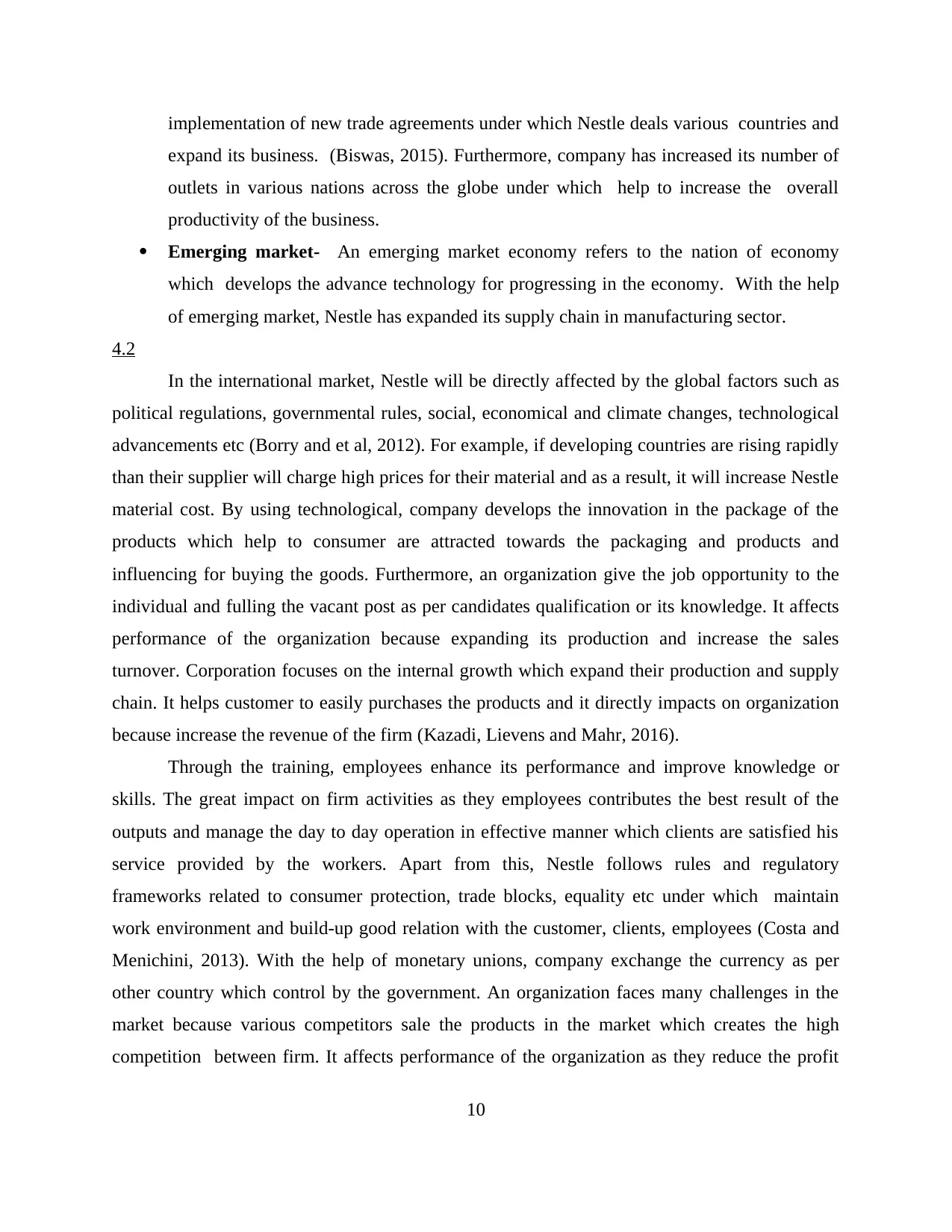
implementation of new trade agreements under which Nestle deals various countries and
expand its business. (Biswas, 2015). Furthermore, company has increased its number of
outlets in various nations across the globe under which help to increase the overall
productivity of the business.
Emerging market- An emerging market economy refers to the nation of economy
which develops the advance technology for progressing in the economy. With the help
of emerging market, Nestle has expanded its supply chain in manufacturing sector.
4.2
In the international market, Nestle will be directly affected by the global factors such as
political regulations, governmental rules, social, economical and climate changes, technological
advancements etc (Borry and et al, 2012). For example, if developing countries are rising rapidly
than their supplier will charge high prices for their material and as a result, it will increase Nestle
material cost. By using technological, company develops the innovation in the package of the
products which help to consumer are attracted towards the packaging and products and
influencing for buying the goods. Furthermore, an organization give the job opportunity to the
individual and fulling the vacant post as per candidates qualification or its knowledge. It affects
performance of the organization because expanding its production and increase the sales
turnover. Corporation focuses on the internal growth which expand their production and supply
chain. It helps customer to easily purchases the products and it directly impacts on organization
because increase the revenue of the firm (Kazadi, Lievens and Mahr, 2016).
Through the training, employees enhance its performance and improve knowledge or
skills. The great impact on firm activities as they employees contributes the best result of the
outputs and manage the day to day operation in effective manner which clients are satisfied his
service provided by the workers. Apart from this, Nestle follows rules and regulatory
frameworks related to consumer protection, trade blocks, equality etc under which maintain
work environment and build-up good relation with the customer, clients, employees (Costa and
Menichini, 2013). With the help of monetary unions, company exchange the currency as per
other country which control by the government. An organization faces many challenges in the
market because various competitors sale the products in the market which creates the high
competition between firm. It affects performance of the organization as they reduce the profit
10
expand its business. (Biswas, 2015). Furthermore, company has increased its number of
outlets in various nations across the globe under which help to increase the overall
productivity of the business.
Emerging market- An emerging market economy refers to the nation of economy
which develops the advance technology for progressing in the economy. With the help
of emerging market, Nestle has expanded its supply chain in manufacturing sector.
4.2
In the international market, Nestle will be directly affected by the global factors such as
political regulations, governmental rules, social, economical and climate changes, technological
advancements etc (Borry and et al, 2012). For example, if developing countries are rising rapidly
than their supplier will charge high prices for their material and as a result, it will increase Nestle
material cost. By using technological, company develops the innovation in the package of the
products which help to consumer are attracted towards the packaging and products and
influencing for buying the goods. Furthermore, an organization give the job opportunity to the
individual and fulling the vacant post as per candidates qualification or its knowledge. It affects
performance of the organization because expanding its production and increase the sales
turnover. Corporation focuses on the internal growth which expand their production and supply
chain. It helps customer to easily purchases the products and it directly impacts on organization
because increase the revenue of the firm (Kazadi, Lievens and Mahr, 2016).
Through the training, employees enhance its performance and improve knowledge or
skills. The great impact on firm activities as they employees contributes the best result of the
outputs and manage the day to day operation in effective manner which clients are satisfied his
service provided by the workers. Apart from this, Nestle follows rules and regulatory
frameworks related to consumer protection, trade blocks, equality etc under which maintain
work environment and build-up good relation with the customer, clients, employees (Costa and
Menichini, 2013). With the help of monetary unions, company exchange the currency as per
other country which control by the government. An organization faces many challenges in the
market because various competitors sale the products in the market which creates the high
competition between firm. It affects performance of the organization as they reduce the profit
10
Paraphrase This Document
Need a fresh take? Get an instant paraphrase of this document with our AI Paraphraser
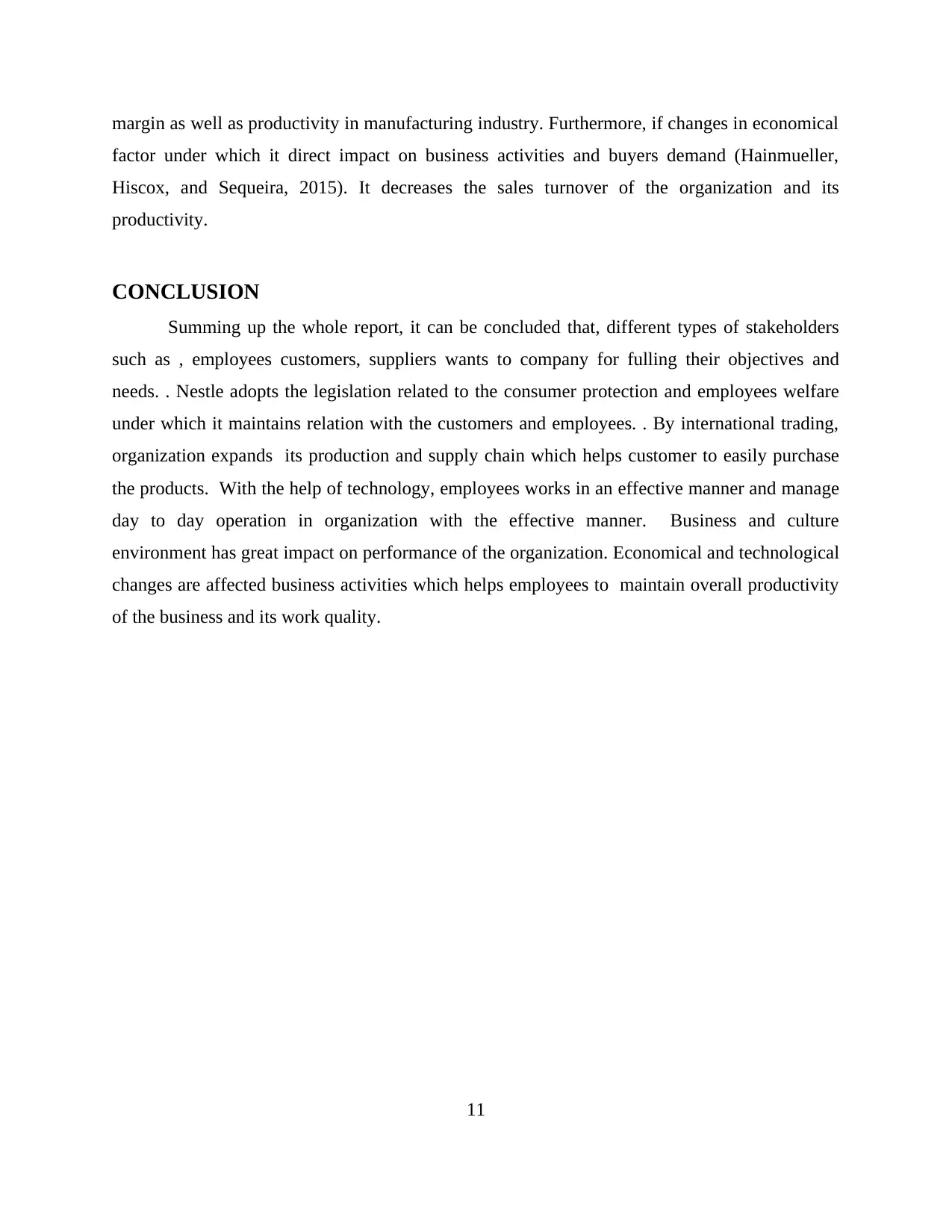
margin as well as productivity in manufacturing industry. Furthermore, if changes in economical
factor under which it direct impact on business activities and buyers demand (Hainmueller,
Hiscox, and Sequeira, 2015). It decreases the sales turnover of the organization and its
productivity.
CONCLUSION
Summing up the whole report, it can be concluded that, different types of stakeholders
such as , employees customers, suppliers wants to company for fulling their objectives and
needs. . Nestle adopts the legislation related to the consumer protection and employees welfare
under which it maintains relation with the customers and employees. . By international trading,
organization expands its production and supply chain which helps customer to easily purchase
the products. With the help of technology, employees works in an effective manner and manage
day to day operation in organization with the effective manner. Business and culture
environment has great impact on performance of the organization. Economical and technological
changes are affected business activities which helps employees to maintain overall productivity
of the business and its work quality.
11
factor under which it direct impact on business activities and buyers demand (Hainmueller,
Hiscox, and Sequeira, 2015). It decreases the sales turnover of the organization and its
productivity.
CONCLUSION
Summing up the whole report, it can be concluded that, different types of stakeholders
such as , employees customers, suppliers wants to company for fulling their objectives and
needs. . Nestle adopts the legislation related to the consumer protection and employees welfare
under which it maintains relation with the customers and employees. . By international trading,
organization expands its production and supply chain which helps customer to easily purchase
the products. With the help of technology, employees works in an effective manner and manage
day to day operation in organization with the effective manner. Business and culture
environment has great impact on performance of the organization. Economical and technological
changes are affected business activities which helps employees to maintain overall productivity
of the business and its work quality.
11
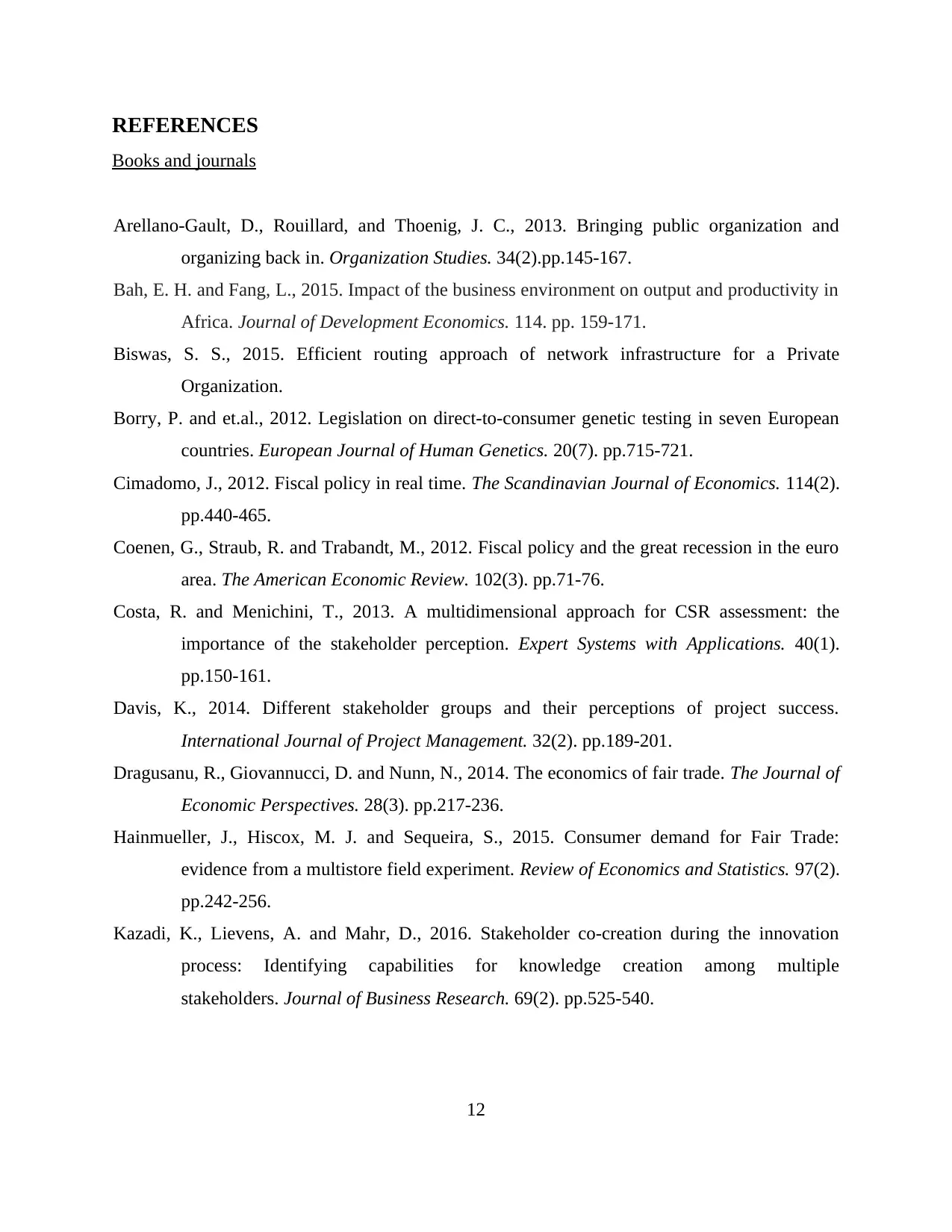
REFERENCES
Books and journals
Arellano-Gault, D., Rouillard, and Thoenig, J. C., 2013. Bringing public organization and
organizing back in. Organization Studies. 34(2).pp.145-167.
Bah, E. H. and Fang, L., 2015. Impact of the business environment on output and productivity in
Africa. Journal of Development Economics. 114. pp. 159-171.
Biswas, S. S., 2015. Efficient routing approach of network infrastructure for a Private
Organization.
Borry, P. and et.al., 2012. Legislation on direct-to-consumer genetic testing in seven European
countries. European Journal of Human Genetics. 20(7). pp.715-721.
Cimadomo, J., 2012. Fiscal policy in real time. The Scandinavian Journal of Economics. 114(2).
pp.440-465.
Coenen, G., Straub, R. and Trabandt, M., 2012. Fiscal policy and the great recession in the euro
area. The American Economic Review. 102(3). pp.71-76.
Costa, R. and Menichini, T., 2013. A multidimensional approach for CSR assessment: the
importance of the stakeholder perception. Expert Systems with Applications. 40(1).
pp.150-161.
Davis, K., 2014. Different stakeholder groups and their perceptions of project success.
International Journal of Project Management. 32(2). pp.189-201.
Dragusanu, R., Giovannucci, D. and Nunn, N., 2014. The economics of fair trade. The Journal of
Economic Perspectives. 28(3). pp.217-236.
Hainmueller, J., Hiscox, M. J. and Sequeira, S., 2015. Consumer demand for Fair Trade:
evidence from a multistore field experiment. Review of Economics and Statistics. 97(2).
pp.242-256.
Kazadi, K., Lievens, A. and Mahr, D., 2016. Stakeholder co-creation during the innovation
process: Identifying capabilities for knowledge creation among multiple
stakeholders. Journal of Business Research. 69(2). pp.525-540.
12
Books and journals
Arellano-Gault, D., Rouillard, and Thoenig, J. C., 2013. Bringing public organization and
organizing back in. Organization Studies. 34(2).pp.145-167.
Bah, E. H. and Fang, L., 2015. Impact of the business environment on output and productivity in
Africa. Journal of Development Economics. 114. pp. 159-171.
Biswas, S. S., 2015. Efficient routing approach of network infrastructure for a Private
Organization.
Borry, P. and et.al., 2012. Legislation on direct-to-consumer genetic testing in seven European
countries. European Journal of Human Genetics. 20(7). pp.715-721.
Cimadomo, J., 2012. Fiscal policy in real time. The Scandinavian Journal of Economics. 114(2).
pp.440-465.
Coenen, G., Straub, R. and Trabandt, M., 2012. Fiscal policy and the great recession in the euro
area. The American Economic Review. 102(3). pp.71-76.
Costa, R. and Menichini, T., 2013. A multidimensional approach for CSR assessment: the
importance of the stakeholder perception. Expert Systems with Applications. 40(1).
pp.150-161.
Davis, K., 2014. Different stakeholder groups and their perceptions of project success.
International Journal of Project Management. 32(2). pp.189-201.
Dragusanu, R., Giovannucci, D. and Nunn, N., 2014. The economics of fair trade. The Journal of
Economic Perspectives. 28(3). pp.217-236.
Hainmueller, J., Hiscox, M. J. and Sequeira, S., 2015. Consumer demand for Fair Trade:
evidence from a multistore field experiment. Review of Economics and Statistics. 97(2).
pp.242-256.
Kazadi, K., Lievens, A. and Mahr, D., 2016. Stakeholder co-creation during the innovation
process: Identifying capabilities for knowledge creation among multiple
stakeholders. Journal of Business Research. 69(2). pp.525-540.
12
⊘ This is a preview!⊘
Do you want full access?
Subscribe today to unlock all pages.

Trusted by 1+ million students worldwide
1 out of 13
Related Documents
Your All-in-One AI-Powered Toolkit for Academic Success.
+13062052269
info@desklib.com
Available 24*7 on WhatsApp / Email
![[object Object]](/_next/static/media/star-bottom.7253800d.svg)
Unlock your academic potential
Copyright © 2020–2025 A2Z Services. All Rights Reserved. Developed and managed by ZUCOL.





